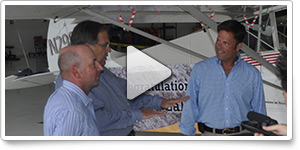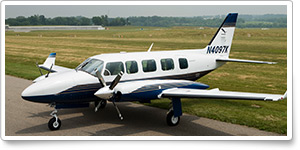Oct. 19, 2012, issue of 'AOPA ePilot: Flight Training Edition' weekly newsletter
| ||||||
| Gusting and variable |
| |||||
Training TipsGusting and variable
Already, training has taught you to accept such surprises as normal. Now the task is to assess the current conditions and decide whether they still meet your standards for flying. If so, how will you adjust your technique?
Checking the newest METAR, you verify that the surface wind speed is within the limits authorized for your solo flights, and that the crosswind component is also acceptable.
The peak gusts being reported, on the other hand, have been nudging both limits. And there’s an additional factor: After the wind value, there is a letter V, followed by more numbers.
That small alphanumeric cluster contains some critical information about the wind: “If the winds are gusting, the letter ‘G’ follows the wind speed (G26). After the letter ‘G,’ the peak gust recorded is provided,” explains Chapter 12 of the Pilot’s Handbook of Aeronautical Knowledge. “If the wind varies more than 60 degrees and the wind speed is greater than six knots, a separate group of numbers, separated by a ‘V,’ will indicate the extremes of the wind directions.”
Taxiing out, it is imperative to position the controls appropriately for the wind conditions; remember to adjust the deflections each time you change direction, as when turning onto a taxiway or into the runup area. Running up into the wind, if possible, is good practice, especially under windy conditions.
Takeoff will call for specialized technique that gets you airborne with maximum control effectiveness, while giving the gusts the respect they deserve.
Remember that gusts and variable wind directions hint at generally turbulent conditions, so tighten your seatbelt and make extra certain that your seat is locked into its position. Keep tabs on the wind reports while airborne so that for landing you can adjust your approach airspeed for the current gust factor.
Stay alert! Pilots not ready to handle wind gusts frequently get into trouble.
How frequently? Here’s a rough measure: Using the word gust as a search term of National Transportation Safety Board accident summaries produced 3,013 “hits.” Flight Training NewsGAO calls for more GA reporting in the interest of safetyThe Government Accountability Office (GAO) on Oct. 4 called for the FAA to consider requiring aircraft owners to report hours flown—possibly in conjunction with annual inspections—and also called for a mandate for pilots to report recurrent training. The GAO’s recommendation is included in a report in which it found that more information is needed before conclusions can be drawn about the root causes of general aviation accidents. Read more >> Catalina’s first airshow flies into historyCatalina Island, Calif., held its first airshow, commemorating the 100th anniversary of Glenn L. Martin’s historic flight to the island on May 10, 1912. The show attracted aircraft ranging from Clay Lacy's DC-3 to Frank Donnelly’s Taylorcraft. Read more and view a slideshow >> Attend a free seminarWho wouldn’t jump at the occasion to get something for free? Here’s your chance to raise the bar to improve aviation safety: an Air Safety Institute live safety seminar packed with exciting and educational content. Join the Air Safety Institute in exploring how aging as a pilot may affect our flying and identify different ways to maintain the same high level of safety over a lifetime of flying. Mark your calendar to attend a free “Flying for a Lifetime” seminar in your area. FMU program acquires Cessna 172Florida Memorial University’s aviation and safety department has acquired a Cessna 172. It is the program’s first aircraft and will also be available for rent through Endeavor Flight Training at Opa-Locka Executive Airport. At a Sept. 28 dedication ceremony, FMU alumnus Barrington Irving, the first African-American pilot to complete a solo round-the-world flight, called the acquisition “a great day for our program.” Founded in 1985, FMU offers bachelor of science degrees in aeronautical science, airway science, and air traffic control. University of Colorado flying club enjoys resurgenceA once-dormant flying club at the University of Colorado-Boulder is active again, thanks to a new group of participants who started it back up in the fall of 2011. The club offers free ground school to its 150 members, who range from pilots with commercial certificates to flying enthusiasts who just enjoy riding along, according to ColoradoDaily.com. Training ResourcesJust as a human body has a heart and lungs, so too does an aircraft—in the form of its engine and propeller. The proper care and feeding of these vital mechanical systems will ensure a long and healthy service life. Learn how best to care for yours by visiting the Air Safety Institute’s Engine and Propeller online course.
Did you know that student pilots who join AOPA are three times more likely to complete their flight training? Membership includes unlimited access to aviation information by phone (800/USA-AOPA, weekdays from 8:30 a.m. to 6 p.m. Eastern time) or from Flight Training Online or AOPA Online. If you’re not already a member, join today and get the pilot’s edge. Login information is available online. AOPA Husky sweepstakes winner! Career PilotAmerican riled by ‘illegal’ pilot actionsAmerican Airlines, in a letter sent to its pilots’ union, accused the Allied Pilots Association (APA) of engaging in an illegal work slowdown and said that it would take the union to court if pilots continue to disrupt flight schedules. The carrier said pilots were filing last-minute maintenance discrepancies and taxiing slowly, which American said has delayed hundreds of flights. The union has denied involvement in any slowdowns or other work disruption by American’s pilots. “Within 24 hours of being asked to return to the bargaining table, they threaten legal action,” APA spokesman Tom Hoban told the Fort Worth Star-Telegram . “This is akin to being sucker punched.” American said it would seek an injunction if pilots continue to disrupt operations. Southwest opens Denver crew baseSouthwest Airlines opened its newest pilot and flight attendant crew bases at Denver International Airport on Oct. 1. The new crew domiciles—the airline’s ninth—will be home to nearly 400 pilots and 400 flight attendants. Southwest also started performing line maintenance in Denver. “The new crew bases and our line maintenance demonstrate our long-term commitment to Colorado and our successful operation at DIA,” said Mike Van de Ven, Southwest’s executive vice president and chief operating officer. Southwest already operates crew bases at Baltimore/Washington; Chicago Midway; Dallas; Houston; Phoenix; Oakland, Calif.; Orlando; and Las Vegas. The carrier began service to Denver on Jan. 3, 2006. Plane SpotterFlocking together: Piper Navajo family Training Products‘Fly the Engine’ by Kas ThomasA revised and updated version of Kas Thomas’ book, Fly the Engine, is back in print and available in hard copy or e-book from Aircraft Spruce. The book covers all phases of engine operation and discusses how to spot engine discrepancies on preflight; how to start a hot, cold, or flooded engine; and how to troubleshoot a rough runup, among many other topics. The hard-cover version is $32.55; the e-book version is $34.95. Order online or call 877/477-7423.
Note: Products listed have not been evaluated by ePilot editors unless otherwise noted. AOPA assumes no responsibility for products or services listed or for claims or actions by manufacturers or vendors. Member BenefitsVisit the AOPA Insurance Services headquartersAt the office of AOPA Insurance Services in Wichita, Kan., employees are always happy to greet any members who drop in—such as 56-year AOPA member and 10-year AOPA Insurance Services customer Dennis Oliver. Oliver, 75 years old and still flying strong, met with Team Lead Shelly Kalal and even got his picture snapped with her while he was there. You’re sure to find an affordable policy that meets all of your coverage needs, and since it’s from AOPA, you can rest assured that the insurance is based more on how your world looks from the cockpit than on how you look on an actuarial table. Visit AOPA Insurance Services online, or if you are in the area, stop in and see us. NASA report: Your get-out-of-jail-free card?As a pilot, one of the tools in your flight bag is the Aviation Safety Reporting System (ASRS), otherwise known to many as the “NASA report.” It’s a program designed to get valuable information about what is going on in the system from those who are actually using the system. Kathy Yodice, an aviation attorney for AOPA’s Pilot Protection Service and Legal Services Plan, explains how the program works and how it benefits you. Read more >> BlogsCross-country to SummitNewly soloed student pilot Pete Nardo and his flight instructor, Ron Klutts, made the trek to AOPA Aviation Summit in Palm Springs, Calif. For Nardo, it was more than a cross-country—it was also a chance to revel in aviation. Read more in the Flight Training blog. Wish lists and budget buysAOPA Online Managing Editor Alyssa J. Miller is just back from AOPA Aviation Summit, and while she was there she roamed the exhibit hall and put together a renter pilot’s wish list. Read her picks in the Reporting Points blog. AOPA Career OpportunitiesEver dream of turning your passion for aviation into a career? We’re looking for a strategy and financial analyst, executive assistant, director of media relations, major gifts officer, and Web graphic designer. To learn more about other AOPA career opportunities, visit AOPA Online. Community
AVIATION EVENTS & WEATHER
| ||||||||||||||||||||||||||||||||||||




 The wind is blowing pretty hard as you head out to preflight your trainer for a local solo practice session. That’s evident from the most recent aviation routine weather report (METAR), and from the erratic behavior of the windsock. It’s also an unexpected development, as the terminal forecast hinted at no such condition.
The wind is blowing pretty hard as you head out to preflight your trainer for a local solo practice session. That’s evident from the most recent aviation routine weather report (METAR), and from the erratic behavior of the windsock. It’s also an unexpected development, as the terminal forecast hinted at no such condition.




